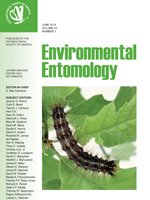The Mexican fruit fly, Anastrepha Indens (Loew), is one of the 10 worldwide more important fruit crop pests. Orchards of southeastern Chiapas also shelter the tree-dwelling lizard Norops serranoi (Köhler), which likely prey upon these flies. In standard laboratory conditions, we determined the functional response of four male and four female lizards on mass-reared fruit flies. We used a general logistic analysis of proportion of killed prey versus available prey to determine the shape of the functional response. Male lizards showed a type II functional response, while females showed a type III functional response. For the highest fruit fly densities, female lizards caught significantly more fruit flies than males did. The predator evasion ability and the survival of mass-reared and wild fruit flies were compared. Wild fruit flies evaded more male lizard attacks than mass-reared flies. However, when female lizards attacked, there was no significant difference between strains. Fruit flies survival was higher with male than with female lizards, but it did not depend on fruit fly strains. This is the first report of a vertebrate preying on the Mexican fruit fly, demonstrating that female lizards impose a higher predation pressure and are more efficient at capturing wild fruit flies than males. We discuss the implications of our results on mass-rearing and quality control of sterile flies.
How to translate text using browser tools
1 June 2014
Predation of Anastrepha ludens (Diptera: Tephritidae) by Norops serranoi (Reptilia: Polychrotidae): Functional Response and Evasion Ability
Ariane Dor,
Javier Valle-Mora,
Susana Eva Rodríguez-Rodríguez,
Pablo Liedo
ACCESS THE FULL ARTICLE
It is not available for individual sale.
This article is only available to subscribers.
It is not available for individual sale.
It is not available for individual sale.

Environmental Entomology
Vol. 43 • No. 3
June 2014
Vol. 43 • No. 3
June 2014




